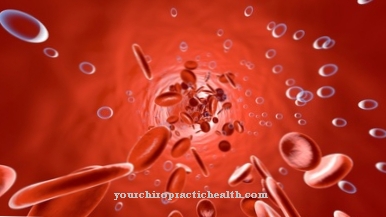When breathing, O2 is absorbed into the blood and CO is released through the blood. The Oxygen tension or also the Oxygen partial pressure is the proportion of oxygen in the blood gas mixture. The doctor usually determines all blood gases for clinical diagnostics and thus collects information on respiratory insufficiency, for example.
What is the oxygen tension?

The human lungs are primarily responsible for breathing. Gas exchange takes place in the alveoli of the lungs. CO is given off. Oxygen is absorbed from the air we breathe and transported to all regions and tissues of the body via the blood as a transport medium.
The oxygen supply to organs and tissues is vital. If the oxygen supply fails, the body tissues are damaged in a very short time. Cells cannot maintain their metabolic processes without oxygen. For this reason they die after a certain time when the blood no longer carries oxygen. In addition to transporting oxygen in dissolved form, the blood is also responsible for transporting bound oxygen. To do this, O2 binds to the hemoglobin of the blood.
The physician understands the oxygen tension to be the partial pressure of oxygen in the blood. This value is known as pO2 and, together with the carbon dioxide partial pressure, forms the blood gas values. The pO2 is accordingly the proportion of oxygen in the total pressure of the blood gas mixture. According to Dalton's law, the partial pressures of individual gases in the blood add up to the total pressure.
Function & task
As breathing gas, oxygen is one of the most important blood gases.In addition to oxygen, the blood also transports carbon dioxide as a waste product from respiration. In addition to oxygen and carbon dioxide, the base excess, the pH value and the bicarbonate are among the blood gas values. Each of these parameters play a role in breathing. For example, the pH value influences the binding affinity of hemoglobin for oxygen, which is essential for transport. The oxygen content and oxygen saturation of the blood are also important parameters.
In normal breathing air, the proportion of oxygen is around 21 percent. At sea level there is a total air pressure of around 101 kPa. This results in an oxygen partial pressure of around 21 kPa. The oxygen partial pressure in arterial blood is lower and can be between 9.5 and 13.3 kPa in terms of age physiology. The partial pressure correlates according to the formula c = α times P with the respective concentration of the gas. α corresponds to the Bunsen's solubility coefficient, c is the concentration and P corresponds to the partial pressure.
The lower the partial pressure, the lower the percentage of oxygen in the blood. The substance-specific constant α influences the solubility. This constant is much higher for carbon dioxide than for oxygen. The oxygen partial pressure is therefore important for the solubility and for the transport of O2 in the blood.
If the partial pressure values for oxygen drop too low, the oxygen supply to the body tissues is impaired. In addition, if the body cannot breathe out enough carbon dioxide, the carbon dioxide builds up and the blood becomes acidic (pH value). The more acidic the blood, the less binding affinity there is between oxygen and hemoglobin. The carbon dioxide has a far more affinity for binding to hemoglobin than oxygen. When it is present in high concentrations in the blood, it can therefore displace oxygen from the hemoglobin. On the other hand, increased exhalation of CO makes the blood basic.
The determination of the oxygen partial pressure, the carbon partial pressure and the pH value therefore provides decisive information on lung health. The blood gas values are closely interlinked. A changed partial pressure for one of the gases always changes the value for the other gas.
You can find your medication here
➔ Medication for shortness of breath and lung problemsIllnesses & ailments
Blood gas tests are almost exclusively carried out in clinical settings and in intensive care medicine. As a rule, the determination is only necessary for seriously ill patients, for example to monitor patients on a ventilator. Due to the close relationship between the individual blood gas values, the doctor usually considers the parameters in clinical diagnostics together and thus determines, for example, the severity of respiratory or metabolic disorders.
A typical illness with altered blood gas values is respiratory failure. A disorder of pulmonary gas exchange is referred to as such. Partial respiratory failure or pulmonary insufficiency corresponds to isolated arterial hypoxemia. There is therefore a lack of oxygen in the arterial blood, which results in an insufficient supply of the body tissues. This phenomenon causes the oxygen partial pressure to fall below the limit of 70 mmHg. The carbon dioxide is either normal or also reduced.
With global respiratory insufficiency, hypoxemia and so-called hypercapnia occur. The carbon dioxide partial pressure increases pathologically to over 45 mmHg and allows the oxygen partial pressure to drop to a greater or lesser extent. In addition to dyspnoea and cyanosis, the most important symptoms of respiratory failure are, above all, internal restlessness, confusion and a racing heart. Depending on the cause, these complaints can be associated with other symptoms.
In addition to respiratory insufficiency, oxygen partial pressure also plays a role in tachypnea. This is an increased breathing rate, as occurs when there is an increased need for oxygen. The depth of breath is either reduced, constant or excessive. Tachypnea is symptomatic of many diseases, as the phenomenon occurs, for example, in the context of fever reactions. Tachypnea is more specific for heart and lung diseases. The organism tries to compensate for the reduced oxygen supply by increasing the work of breathing. As a rule, tachypnea manifests itself through pathologically changed blood gas values. Theoretically, however, the phenomenon can also occur with physiological blood gases, for example as hyperventilation syndrome in the case of psychological excitement.













.jpg)

.jpg)
.jpg)











.jpg)